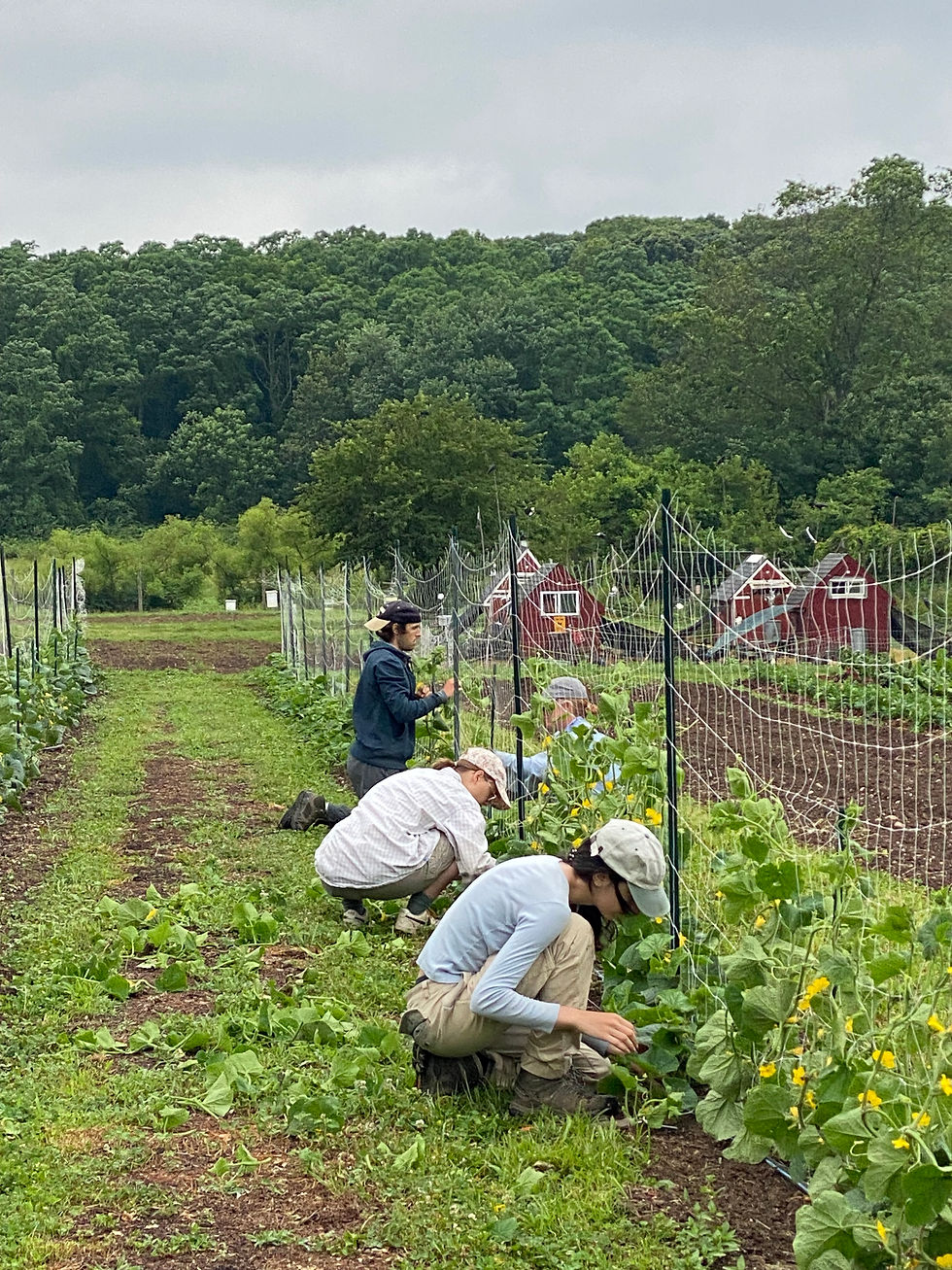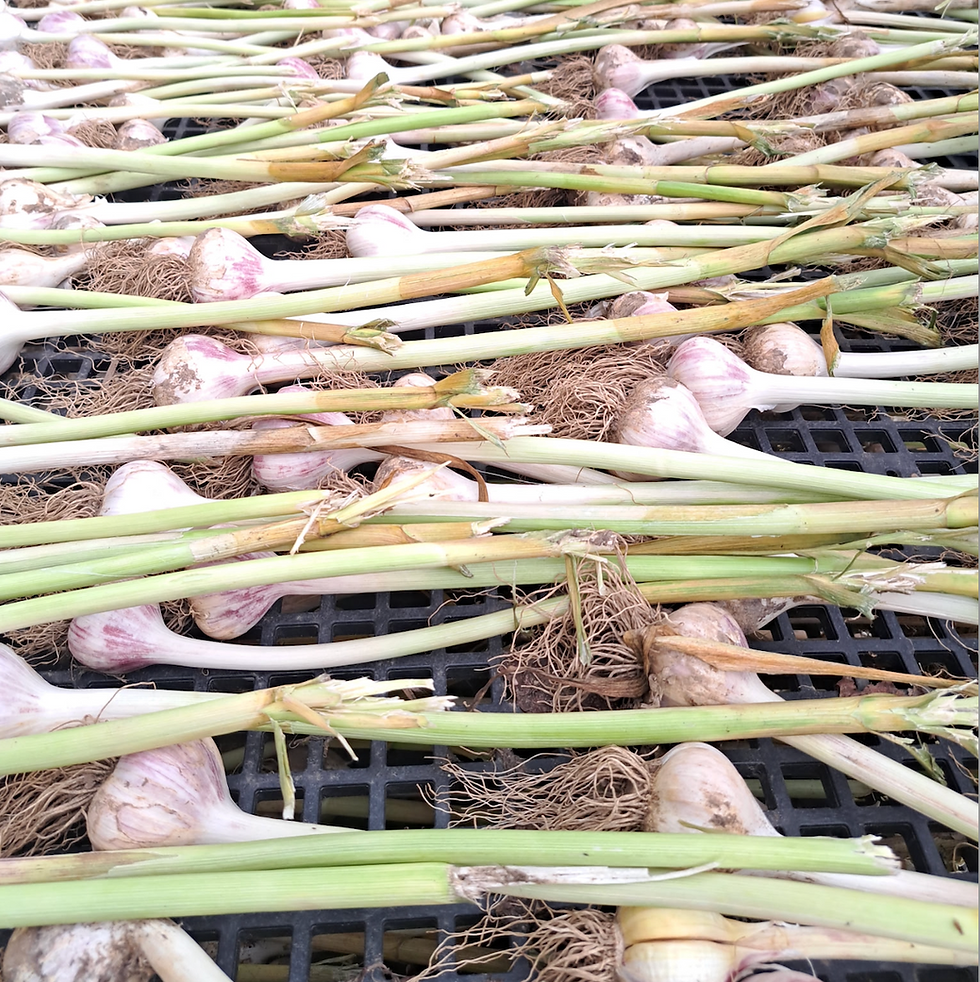The Rate is the Rate
- Caroline Fanning
- Jul 13, 2025
- 4 min read
July 15, 2025
We’ve been mulching our brains out. In June we mulched the kale, chard, and parsley. Last week we finished the tomatoes. Next up are peppers and eggplant. Even as many other farms transition to plastic mulch, we’ve held onto the free, organic option—leaves, as many as we can stockpile in the fall. Leaf mulch is great at suppressing weeds, retaining moisture, and building organic matter. The challenge is applying the leaves at the height of summer, when humidity and temperatures are soaring. Our tractor can dump a bucket of leaves into 3 wheelbarrows at once, and we’ve found that the best machine-to-human ratio is one tractor to 6 people with 6 wheelbarrows. This keeps the tractor in motion while allowing for individual water breaks for the ground crew. But it’s still dirty, heavy work, and it might be tempting to cut corners, i.e. skimp on volume. But as Thomas quoted from his previous employer, the rate is the rate. That is, do it right, or don’t do it at all. Fortunately, our crew is committed to doing it right. Wish the same could be said of other institutions.

Running a diversified farm often brings to mind the phrase jack of all trades, master of none. With hundreds of varieties planted, we can’t give too much attention to a single crop. Take cucumbers and zucchini, for example. They’re similar in terms of season and growth habit, but cukes are much more susceptible to disease and water stress. We trellis and prune the cukes to mitigate disease, but we can’t tweak the water—the irrigation is either on or off, for zukes and cukes alike. So we do our best and hope the conditions are favorable. When they’re not, we’re as bummed as our customers, but we never lose faith in diversity. Without it, we’re just a monoculture—and don’t get me started on the pitfalls of that.

So, how do you train a new crew when there are hundreds of varieties to learn, and when field conditions change daily? I’m still figuring it out. Currently, I aim to demonstrate with as many visuals, and as few words, as possible. When it comes to hand weeding, I start by having the crew watch so they can observe my technique and the finished product. Then I provide a numeric—80%, 90%, or 99%. When weeding tomatoes or eggplant, neutralizing 80% of the weeds is good enough. But young carrots don’t stand a chance against summer weeds, so we aim for 99%. Some crew members are hard-wired for 80%, and others for 99%. By working alongside the crew, I’m able to reinforce the standard and the pace for a particular crop. It builds camaraderie on any day; when it’s 95 degrees and humid, serious bonds are forged.

Speaking of humid, I can’t remember the last time it wasn’t. The wet spring has morphed into a wet summer, and Dan and I are keeping a sharp eye out for disease. Last year we incurred big losses from phytophthora, a water-mold that wiped out 90% of our winter squash. The only other time we incurred such a major loss was in 2009, when the same pathogen decimated our tomatoes. But we’ve also had plenty of seasons where wet conditions yielded bumper crops. So what creates the perfect storm? You’d have to ask a Cornell scientist. On our part, we’re removing diseased plants when we see them, not overwatering (sorry cukes!), and keeping our fingers crossed.
We’re halfway through garlic harvest. The bulbs are smaller than usual, but we anticipated that. We planted in New Pond Field, which was a cow pasture until 2023. Unlike the rest of the farm, which has benefitted from regular applications of compost, mulch, and cover crop, New Pond is low in organic matter and high in perennial weeds. When we broke ground two years ago, crew member Adam Li took soil samples; the organic matter in New Pond was 3.6%, whereas in in Old Pond it was 6.7%. But you gotta start somewhere, and garlic is a great place to start. We apply about 20 yards of leaf mulch on ¼ acre of garlic every fall. It’s a lot of organic matter for the soil to digest, but if you allow adequate time, the soil will digest it gladly. New Pond organic matter is bound to rise in the upcoming years, and so will future harvests. Plus, I gotta believe that our garlic seed, which we’ve been saving since 2007, carries the genetic memory of the past. That is, our stock remains strong, even if this year’s environment is yielding sub-par results. Another metaphor for present times, in case you’re keeping track.

Circling back to humidity, it’s no friend of garlic at curing time. Fortunately, the same crew members who are programmed to weed at 99% are also programmed to remove all the brown and yellowed leaves that compromise garlic in storage. So even though the garlic has been exiting that fields more slowly than usual, it’s looking better than usual in storage.

Our intrepid crew shifts this week. Alice departs for a summer program in Zurich, where she will be studying sustainable urban design. We wish her all the best! Arriving just in time to fill Alice’s shoes are Arturo Milla Gavidia, Sarah Lynas Koenig, and Kennedy Wilson. We’re grateful to have them on the mulching crew! And from the look of the tomatoes, peppers, and eggplant, we’ll be happy to have them on the harvesting crew, too. Many hands—and a good sense of humor—make light work.
Thanks for reading,
Caroline






















Comments